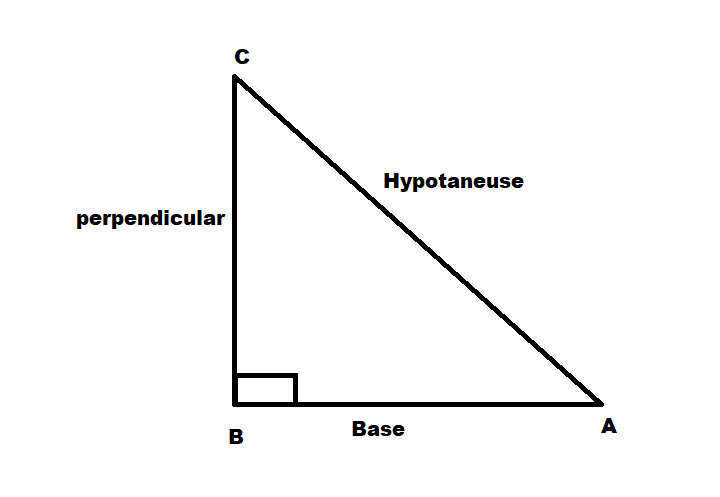
If \[\sin A = \dfrac{1}{3}\] ,then find the value of \[\cos A,\csc A + \tan A\] and \[\sec A\].
Answer
575.1k+ views
Hint: We are given the value of $\sin A$ therefore we can use the ratio of sine and then use the Pythagoras theorem of triangles to get the unknown values and then substitute the values in the formulas of trigonometric ratios to get the desired answers.

\[\sin \theta = \dfrac{{{\text{perpendicular}}}}{{{\text{hypotenuse}}}}\]
\[\cos A = \dfrac{{{\text{base}}}}{{{\text{hypotenuse}}}}\]
\[\csc A = \dfrac{1}{{\sin A}}\]
\[\tan A = \dfrac{{{\text{perpendicular}}}}{{{\text{base}}}}\]
Complete Step-by-step Solution
Given:
$\sin A= \dfrac{1}{3}$
Now, as we know that:
\[\sin \theta = \dfrac{{{\text{perpendicular}}}}{{{\text{hypotenuse}}}}\]
Comparing the values we get:
\[
{\text{perpendicular}} = 1 \\
{\text{hypotenuse}} = 3 \\
\]
According to Pythagoras theorem of right angled triangle:
\[{\left( {{\text{perpendicular}}} \right)^2} + {\left( {{\text{base}}} \right)^2} = {\left( {{\text{hypotenuse}}} \right)^2}\]
Hence substituting the known values we get:
\[
{\left( 1 \right)^2} + {\left( {{\text{base}}} \right)^2} = {\left( 3 \right)^2} \\
{\left( {{\text{base}}} \right)^2} = 9 - 1 \\
{\left( {{\text{base}}} \right)^2} = 8 \\
{\text{base}} = 2\sqrt 2 \\
\]
Now since we know that:
\[\cos A = \dfrac{{{\text{base}}}}{{{\text{hypotenuse}}}}\]
Therefore, substituting the values we get:
\[\cos A = \dfrac{{2\sqrt 2 }}{3}\]
Now we know that:
\[\csc A = \dfrac{1}{{\sin A}}\] and \[\tan A = \dfrac{{{\text{perpendicular}}}}{{{\text{base}}}}\]
Hence substituting the values we get:
\[
\csc A = 3 \\
\tan A = \dfrac{1}{{2\sqrt 2 }} \\
\]
Now adding both the terms we get:
\[
\csc A + \tan A = 3 + \dfrac{1}{{2\sqrt 2 }} \\
\csc A + \tan A = \dfrac{{3\left( {2\sqrt 2 } \right) + 1\left( 1 \right)}}{{2\sqrt 2 }} \\
\csc A + \tan A = \dfrac{{6\sqrt 2 + 1}}{{2\sqrt 2 }} \\
\]
Now, as we know that:
\[\sec A = \dfrac{1}{{\cos A}}\]
Substituting the values we get:
\[\sec A = \dfrac{3}{{2\sqrt 2 }}\]
$\therefore $ The required values are \[\cos A = \dfrac{{2\sqrt 2 }}{3}\], $\csc A + \tan A = \dfrac{{6\sqrt 2 + 1}}{{2\sqrt 2 }}$ and $\sec A = \dfrac{3}{{2\sqrt 2 }}$
Note:
The trigonometric functions are the ratios of the sides of the right angled triangle.
Also, cosec A is the reciprocal of sin A and sec A is the reciprocal of cos A.
The values of cosec A and sec A can also be calculated by the formulas:
\[
\sec A = \dfrac{{{\text{hypotenuse}}}}{{{\text{base}}}} \\
\csc \theta = \dfrac{{{\text{hypotenuse}}}}{{{\text{perpendicular}}}} \\
\]

\[\sin \theta = \dfrac{{{\text{perpendicular}}}}{{{\text{hypotenuse}}}}\]
\[\cos A = \dfrac{{{\text{base}}}}{{{\text{hypotenuse}}}}\]
\[\csc A = \dfrac{1}{{\sin A}}\]
\[\tan A = \dfrac{{{\text{perpendicular}}}}{{{\text{base}}}}\]
Complete Step-by-step Solution
Given:
$\sin A= \dfrac{1}{3}$
Now, as we know that:
\[\sin \theta = \dfrac{{{\text{perpendicular}}}}{{{\text{hypotenuse}}}}\]
Comparing the values we get:
\[
{\text{perpendicular}} = 1 \\
{\text{hypotenuse}} = 3 \\
\]
According to Pythagoras theorem of right angled triangle:
\[{\left( {{\text{perpendicular}}} \right)^2} + {\left( {{\text{base}}} \right)^2} = {\left( {{\text{hypotenuse}}} \right)^2}\]
Hence substituting the known values we get:
\[
{\left( 1 \right)^2} + {\left( {{\text{base}}} \right)^2} = {\left( 3 \right)^2} \\
{\left( {{\text{base}}} \right)^2} = 9 - 1 \\
{\left( {{\text{base}}} \right)^2} = 8 \\
{\text{base}} = 2\sqrt 2 \\
\]
Now since we know that:
\[\cos A = \dfrac{{{\text{base}}}}{{{\text{hypotenuse}}}}\]
Therefore, substituting the values we get:
\[\cos A = \dfrac{{2\sqrt 2 }}{3}\]
Now we know that:
\[\csc A = \dfrac{1}{{\sin A}}\] and \[\tan A = \dfrac{{{\text{perpendicular}}}}{{{\text{base}}}}\]
Hence substituting the values we get:
\[
\csc A = 3 \\
\tan A = \dfrac{1}{{2\sqrt 2 }} \\
\]
Now adding both the terms we get:
\[
\csc A + \tan A = 3 + \dfrac{1}{{2\sqrt 2 }} \\
\csc A + \tan A = \dfrac{{3\left( {2\sqrt 2 } \right) + 1\left( 1 \right)}}{{2\sqrt 2 }} \\
\csc A + \tan A = \dfrac{{6\sqrt 2 + 1}}{{2\sqrt 2 }} \\
\]
Now, as we know that:
\[\sec A = \dfrac{1}{{\cos A}}\]
Substituting the values we get:
\[\sec A = \dfrac{3}{{2\sqrt 2 }}\]
$\therefore $ The required values are \[\cos A = \dfrac{{2\sqrt 2 }}{3}\], $\csc A + \tan A = \dfrac{{6\sqrt 2 + 1}}{{2\sqrt 2 }}$ and $\sec A = \dfrac{3}{{2\sqrt 2 }}$
Note:
The trigonometric functions are the ratios of the sides of the right angled triangle.
Also, cosec A is the reciprocal of sin A and sec A is the reciprocal of cos A.
The values of cosec A and sec A can also be calculated by the formulas:
\[
\sec A = \dfrac{{{\text{hypotenuse}}}}{{{\text{base}}}} \\
\csc \theta = \dfrac{{{\text{hypotenuse}}}}{{{\text{perpendicular}}}} \\
\]
Recently Updated Pages
Two men on either side of the cliff 90m height observe class 10 maths CBSE

What happens to glucose which enters nephron along class 10 biology CBSE

Cutting of the Chinese melon means A The business and class 10 social science CBSE

Write a dialogue with at least ten utterances between class 10 english CBSE

Show an aquatic food chain using the following organisms class 10 biology CBSE

A circle is inscribed in an equilateral triangle and class 10 maths CBSE

Trending doubts
Why is there a time difference of about 5 hours between class 10 social science CBSE

Write a letter to the principal requesting him to grant class 10 english CBSE

What is the median of the first 10 natural numbers class 10 maths CBSE

The Equation xxx + 2 is Satisfied when x is Equal to Class 10 Maths

Which of the following does not have a fundamental class 10 physics CBSE

State and prove converse of BPT Basic Proportionality class 10 maths CBSE




